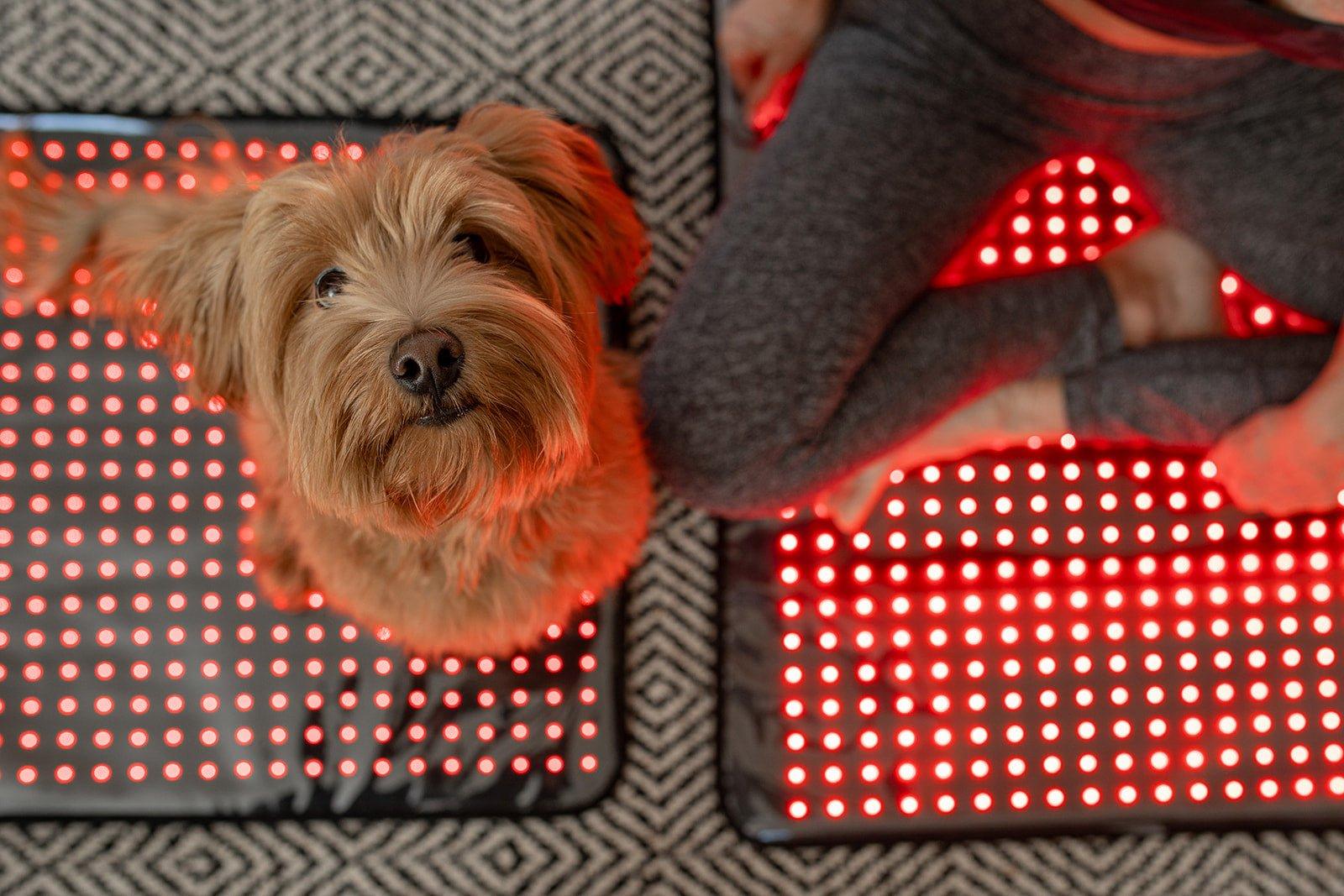Just How Red Light Therapy Can Improve Your Dog's Overall Health
Red Light Therapy has emerged as a promising alternative for enhancing canine health. This non-invasive therapy stimulates mobile task and promotes recovery in canines struggling with numerous conditions. Many family pet owners report noticeable advantages, including discomfort relief and improved mobility. Recognizing the prospective applications and hidden systems is crucial. What certain conditions can it attend to, and just how can it be safely incorporated right into a canine's treatment programs? The solutions may shock you.
Recognizing Red Light Therapy: What It Is and How It Functions
Red light therapy has actually acquired appeal in human medication, its application for dogs is progressively acknowledged for its prospective benefits. This non-invasive therapy makes use of specific wavelengths of light, normally in the near-infrared and red spectrum, to stimulate cellular feature. The underlying concept involves the absorption of light by mitochondria, which increases ATP manufacturing and boosts mobile metabolic rate.
As a result, red light therapy promotes enhanced flow and help in cells fixing. The therapy is delivered through gadgets such as lasers or LED panels, which can be guided at certain locations of a pet's body. Therapy sessions are generally brief, making it a hassle-free alternative for pet dog proprietors.
Recognizing this modern technology's devices can aid caretakers make notified decisions concerning their pet's wellness treatment. As study proceeds to evolve, the rate of interest in red light therapy as a corresponding therapy technique for different canine conditions is likely to expand.

Advantages of Red Light Therapy for Dogs
Red light therapy provides several substantial benefits for pets, consisting of efficient discomfort relief and an increased recovery procedure. This therapy can improve mobility and flexibility, making it specifically important for maturing or injured pet dogs. As more family pet owners look for alternative therapies, understanding these benefits becomes progressively vital.
Pain Relief Applications
Lots of dog proprietors are turning to red light therapy as an encouraging service for easing discomfort in their pets. This non-invasive therapy makes use of particular wavelengths of light to permeate the skin, boosting cellular task and reducing swelling. Pets experiencing from persistent problems such as joint inflammation, hip dysplasia, or post-surgical pain may experience considerable alleviation via this therapy. Studies suggest that red light therapy can improve blood flow, helping to provide essential nutrients to affected areas, additionally adding to discomfort decrease. Additionally, it may assist to reduce the dependence on pharmaceutical painkiller, which often come with unfavorable negative effects. Consequently, many veterinarians are increasingly recommending red light therapy as a reliable and safe choice for taking care of discomfort in pets.

Accelerated Recovery Process
The advantages of red light therapy expand past pain relief, playing an important duty in increasing the healing process for canines. This innovative therapy advertises cellular regrowth, boosting the production of ATP, which enhances power schedule for healing tissues. In addition, red light therapy boosts blood circulation, leading to boosted oxygen and nutrient shipment to hurt locations. This increased flow not just aids in faster recuperation however likewise reduces swelling, a typical obstacle to healing. Additionally, the therapy motivates collagen production, crucial for cells repair work and regrowth. Generally, by helping with these organic processes, red light therapy greatly reduces recovery times, permitting canines to go back to their normal tasks much more promptly and with greater vigor.
Enhanced Wheelchair and Versatility
Boosted movement and adaptability are significant advantages of red light therapy for canines, especially for those dealing with joint pain or rigidity. This non-invasive treatment makes use of details wavelengths of light to permeate tissues, promoting boosted blood circulation and reducing inflammation. Because of this, canines often experience relief from discomfort linked with arthritis, hip dysplasia, or post-surgical recovery. Regular sessions can boost cellular fixing and enhance muscle function, enabling pets to regain their all-natural series of motion. Owners have actually reported noticeable enhancements in their family pets' capability to run, jump, and take part in tasks they as soon as appreciated (Red Light Therapy Dogs). Inevitably, red light therapy not only assists relieve pain however also adds to a much more active and meeting way of living for pet dogs, improving their overall quality of life
Problems That Can Be Treated With Red Light Therapy
Red light therapy has obtained popularity in various fields, its application in vet care, particularly for pets, has actually shown promise in dealing with a range of problems. This non-invasive treatment technique is believed to help in alleviating discomfort and inflammation connected with arthritis, aiding older canines gain back wheelchair. Additionally, it has been made use of to assist in the healing of wounds, burns, and medical cuts, promoting faster recuperation times.
Skin disease, such as dermatitis and hot areas, might additionally respond positively to red light therapy, lowering irritation and encouraging much healthier fur development. The therapy can be advantageous for dogs experiencing from problems like hip dysplasia, ligament injuries, and muscle mass stress. By boosting cellular fixing and improving blood circulation, red light therapy provides an all natural strategy to enhancing the overall well-being of canines, supplying relief and promoting a better lifestyle.
The Scientific Research Behind Red Light Therapy
Red light therapy operates the principle of photobiomodulation, which entails the application of details wavelengths of light to stimulate mobile procedures. These wavelengths, generally varying from 600 to 1000 nanometers, permeate the skin and are absorbed by mitochondria, the energy-producing components of cells. This absorption improves ATP production, leading to enhanced power schedule for mobile functions.

Researches suggest that red light therapy may additionally regulate immune reactions and support overall cellular health. By using these organic systems, red light therapy uses a non-invasive therapy alternative that can contribute considerably to a pet's well-being and recovery from various conditions.
How to Incorporate Red Light Therapy Into Your Dog's Regular
Incorporating red light therapy into a pet dog's regimen can be a straightforward process, offered that look at here now animal owners approach you can look here it with treatment and consistency. Picking an ideal device is essential, as alternatives array from handheld systems to bigger panels (Red Light Therapy Dogs). Proprietors need to start by introducing the therapy gradually, enabling their canines to adjust to the light exposure. Procedure can be scheduled for about 10 to 20 mins, preferably 2 to three times a week, relying on the pet dog's demands and the recommendations of a vet
Establishing a comfy setting is essential; using a silent room where the pet dog feels relaxed can enhance the experience. During the sessions, proprietors can engage their pet dogs with relaxing voices or mild stroking to create a relaxing environment. Checking the pet's action is important to ensure the therapy is useful and satisfying, ultimately aiding to improve their total wellness.
Security Considerations and Measures for Red Light Therapy
When considering red light therapy for pet dogs, security ought to always be a leading priority to guarantee a favorable experience. Pet proprietors need to consult a veterinarian prior to starting any kind of therapy, particularly for dogs with pre-existing problems or those taking medications. It is vital to pick tools especially created for pets, as human gadgets might not appropriate.
Appropriate eye protection is essential; both the handler and the pet dog must put on safety glasses to secure their eyes from prospective harm. In addition, sessions must be checked carefully to avoid too much exposure. It is advisable to begin with shorter sessions and progressively increase duration based on the pet's reaction.
Owners need to additionally observe their pets for any indicators of discomfort or adverse responses during and click to investigate after therapy. By adhering to these safety and security considerations, red light therapy can be a valuable and safe choice for enhancing a canine's health.
Often Asked Concerns
Exactly how Commonly Should I Utilize Red Light Therapy on My Dog?

Can Red Light Therapy Change Standard Vet Treatments?
Red light therapy ought to not replace conventional veterinary treatments. While it may match treatments by advertising recovery and lowering pain, getting in touch with a veterinarian stays important for comprehensive care and dealing with hidden wellness concerns in pets.
Exist Any Type Of Side Results of Red Light Therapy for Dogs?
Red light therapy for pet dogs generally has very little side effects, such as temporary skin inflammation or heat at the therapy website. Most canines endure the therapy well, but keeping an eye on for any kind of uncommon reactions is suggested.
What Is the Ideal Period for Each Red Light Therapy Session?
The suitable period for every red light therapy session typically varies from 10 to 20 minutes, depending upon the pet's particular demands and problem. Consultation with a veterinarian is suggested to customize the treatment suitably.
Is Red Light Therapy Appropriate for All Dog Breeds?
Red light therapy is generally ideal for many pet breeds. However, specific health and wellness problems and sensitivities might impact its applicability. Consulting a veterinarian assures the therapy is beneficial and safe for each specific pet.
Many canine proprietors are turning to red light therapy as a promising option for reducing discomfort in their pets. Enhanced wheelchair and versatility are significant advantages of red light therapy for pets, especially for those enduring from joint pain or rigidity. Red light therapy operates on the concept of photobiomodulation, which entails the application of certain wavelengths of light to boost cellular processes. Research indicates that red light therapy can promote recovery, decrease swelling, and reduce pain in pets. Red light therapy for pets typically has marginal side results, such as momentary skin redness or warmth at the treatment site.